After years of advocacy by environmental justice activists, the Biden administration is finally delivering better protections for fenceline communities impacted by toxic air pollution. The new standards for certain chemical manufacturers are aimed at reducing the number of people put at an elevated risk for cancer.
The Environmental Protection Agency (EPA) released on Tuesday a final rule updating Clean Air Act standards to reduce pollution from about 200 chemical manufacturing facilities that environmentalists call “the nation’s most hazardous chemical plants.” The standards are a victory for residents of heavily industrialized areas from California to Appalachia and the Gulf Coast, including the infamous Louisiana industrial corridor known as Cancer Alley, where community activists have fought against environmental racism for decades.
Once implemented, new regulations will slash more than 6,200 tons of toxic air pollutants each year, which will “dramatically” reduce the number of people with elevated risk of cancer in communities surrounding the chemical plants, according to the EPA.
“Waking up every day with the fear of what you’re breathing in is a reality Louisiana’s communities have lived with for too long,” said longtime pollution watchdog Wilma Subra, technical director for the Louisiana Environmental Action Network, in a statement on Tuesday. “Moving toward additional reductions by EPA would assist community members in reducing their body burden of chemical exposure during the remainder of their lives.”
However, President Joe Biden remains neck and neck with former President Donald Trump in the polls as elections approach in November. The previous Trump administration undermined toxic chemical regulations and bulldozed environmental protections while stacking regulatory agencies with industry insiders. The number of EPA enforcement actions against polluters plummeted.
A Trump victory threatens to reverse the modest progress Biden and EPA Administrator Michael Regan have made toward promoting environmental justice in communities most impacted by pollution, which are often lower-income and shaped by legacies of racial segregation. The air pollution standards are also likely to face legal challenges from chemical manufacturers, and The New York Times reported that the pro-industry U.S. Chamber of Commerce wrote a letter urging the EPA to halt implementation due to “scientific uncertainty” behind the rulemaking.
Regan is the first Black person to head the EPA, and in 2021 he toured neighborhoods overburdened by industrial pollution in Cancer Alley and beyond with a pledge to bring environmental justice perspectives to the policymaking table. For years, Democrats have been criticized for paying little more than lip service to the environmental justice movement, but Regan pledged to take the EPA in a new direction.
“We promised to listen to folks that are suffering from pollution and act to protect them,” Regan told reporters on Tuesday. “Today we deliver on that promise with strong final standards to slash pollution, reduce cancer risk, and ensure cleaner air for nearby communities.”
By enforcing tougher standards for emissions and equipment at chemical plants that produce resins and polymers such as neoprene, a synthetic rubber used in wetsuits, the new rule aims to reduce by 80 percent the amount of ethylene oxide and chloroprene released into the air. Both toxic pollutants are carcinogenic.
The new rule also requires the industry to monitor for key pollutants — ethylene oxide, chloroprene, benzene, 1,3-butadiene and vinyl chloride — at the fence line of the facility and report the results to EPA regulators, who will analyze the data and release it to the public. The EPA gave chemical plants covered by the rule a full year to implement the monitoring systems.
Robert Taylor, founder of Concerned Citizens of St. John, an environmental justice group in Cancer Alley up the Mississippi River from New Orleans, said friends and family have suffered from diseases such as cancers due to unregulated chemical plant emissions for years. A recent study found that chemical plants are clustered near Black communities in Louisiana, which face 7 to 21 times more air pollution than industrialized white communities. The group signed onto a civil rights complaint filed with the EPA, and in response, the Biden administration launched an investigation into whether Louisiana regulators violated the Civil Rights Act by failing to protect Black communities from pollution and other environmental hazards.
However, Jeff Landry, Louisiana’s Republican former attorney general and now governor, successfully sued the Biden administration, and in January a Trump-appointed federal judge issued an injunction blocking the EPA and Justice Department from enforcing the Civil Rights Act over racially disproportionate exposure to pollution.
“After the EPA closed our civil rights complaint without resolution, we felt little hope that any government could protect us from industry. But Administrator Regan’s visit to our community and this final rule are renewing our hope,” Taylor said in a statement on Tuesday. “[The new chemical plant rule is] a starting point for lowering toxic emissions and saving the children in our community.”
One of the most contested chemical plants on Taylor’s list is Denka Performance Elastomer, a synthetics and neoprene manufacturer that has gone back and forth with the local community over claims of cancer-causing emissions for years. The facility will be subject to the EPA’s new rule, which the company has said it intends to fight in court, according to The New York Times.
In a statement, the company said it had cut its emissions since 2015 and called the new chemical plant standards a “draconian” step by the EPA that would require the plant to “idle its operations at tremendous expense and risk to its hundreds of dedicated employees,” presumably to clean out equipment to prevent the release of carcinogens into the air.
“Communities’ relentless advocacy for more protective clean air standards is paying off,” said Patton Dycus, an attorney at the Environmental Integrity Project, in a statement. “While we’re concerned that some aspects of the EPA’s final rule aren’t strong enough, the rule is a big step forward in combatting air pollution and protecting vulnerable communities.”
